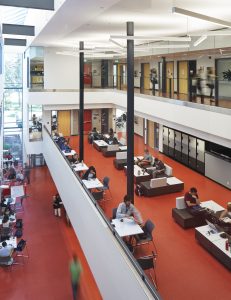
McMaster University building functions as living laboratory of sustainability
November 21, 2017 | By HPAC Magazine

A full-height skylit atrium unites the program areas and connects with the John Hodgins Building, providing views into both spaces. Photo: Lisa Logan Photography
A unique facility for undergraduate engineering opened recently at McMaster University in Hamilton, ON. The Gerald Hatch Centre for Engineering Experiential Learning combines a new home for the undergraduate experiential learning facilities with engineering research in a building that functions as a living laboratory of sustainability.
The design showcases how sustainable technologies can work together to reduce the environmental footprint of the built form and provide a leading edge in advanced green technology and research.
“Central to the project’s design is the concept that the operation and energy-use needs of the building will be a testing ground for an array of green energy-producing research equipment,” said Michael Szabo, principal, Diamond Schmitt Architects. “The building is enabled to pursue zero-net energy and to demonstrate its potential as a stand-alone resilient facility.”
The Hatch Centre incorporates both a conventional heating and cooling system powered by the university’s central plant and integrates research technologies funded by the Canadian Foundation for Innovation. These include solar photovoltaic panels, solar thermal panels, wind turbines, a CHP generator, an intensive building diagnostic system, and a geothermal field. The building envelope incorporates R25 walls, R40 roofs and triple glazing, and through connection with the adjacent John Hodgins Engineering Building, reduces the perimeter by 30 per cent, thereby improving the overall thermal performance.
This new home for the undergraduate engineering teams and clubs comprises a ground floor build space and machine shop for projects, including solar car development and Formula One race team. The second floor houses design labs and collaborative meeting space while the third floor of this compact 26,800 sq. ft. building has student support services.
A release from Hatch Engineering notes that “A tribute to our founder, the Gerald Hatch Centre for Engineering Experiential Learning is now complete and open to students, thanks in large part to a C$3 million dollar donation from The Hatch Family, Kurt Strobele, Bert Wasmund, and Hatch. The contribution to the building’s C$11 million cost demonstrates our strong commitment to supporting the next generation of engineers and helping them develop broader, more holistic problem-solving abilities.”
To see Hatch’s time lapse film of the centre’s two years of construction, click here.




